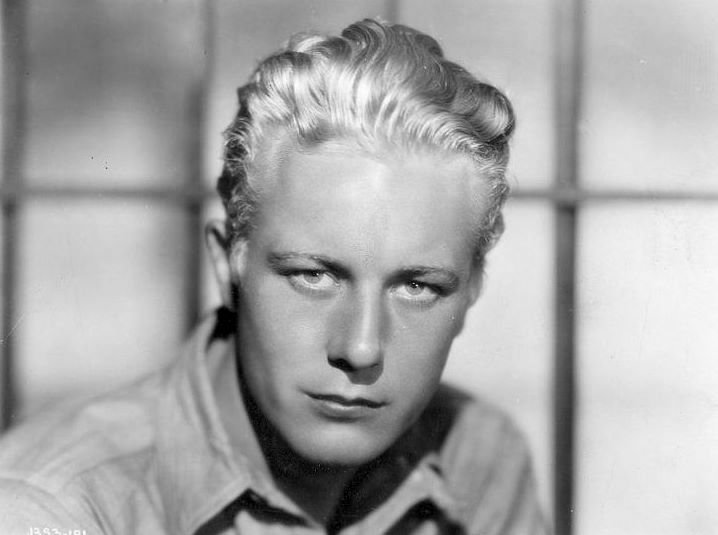Gene Raymond: Wild Orchid
In the 1941 Frank Borzage Technicolor version of Smilin’ Through, Gene Raymond is called upon to jealously shoot Jeanette MacDonald at her wedding to Brian Aherne. In real life, MacDonald and Raymond were married, and not happily. According to Sweethearts, a 2001 biography of MacDonald by Sharon Rich, their marriage was arranged by MGM head Louis B. Mayer, who sought to protect the moneymaking team of MacDonald and Nelson Eddy by preventing their marriage to each other, even though they were very much in love. They were both temperamental, and Mayer feared that if they quickly divorced that their ultra-lucrative star pairing in MGM films would be spoiled. So MacDonald did as she was told and married Raymond, who looked enough like Eddy that he was always being mistaken for him in public. And Raymond was predominantly gay. Rich produces a photo of a 1938 arrest and booking number for Raymond when he was caught with another man, and she interviews two witnesses to his two subsequent arrests, the last when he was serving as a military pilot during World War II.
He was born Raymond Guion in 1908 in New York, and as a youth he played on stage with Mary Boland in The Cradle Snatchers for two years. In the early 1930s, he first made an impact on screen as the husband who leaves wife Mary Astor alone too long in Red Dust (1932), and this established his role in movies as an “other man,” but then he found himself at the center of a truly beautiful and sui generis film, Zoo in Budapest (1933). As Zani, a smiling animal rights activist zoo worker who helps Loretta Young escape from indentured servitude, Raymond is always swinging his body over railings and jumping up over partitions for the fun of it or to help someone out. The black shirt and pants he wears in that movie are so tight that they outline every inch of his body, and he wears a motorcycle cap and a bandana around his neck, so that it feels like Raymond is deliberately bringing a little pre-Kenneth Anger sexiness to this dewy fairy tale. “Thinking? That’s bad. Feeling is alright, but don’t ever think!” Zani tells Young’s runaway, and the unthinking sexual oddity of this character suits Raymond’s bluntness, his unnatural-looking platinum blond hair, and his air of being an extremely horny rabbit of some kind.
Raymond has a very bad habit of widening his eyes whenever he’s supposed to be excited by something on screen, or sometimes he widens them just when he feels like it, so that in some ways he’s the Andrew McCarthy of 1930s cinema. He’s cast as men who try to clip the professional wings of hot-to-trot Bette Davis in Ex-Lady (1933) and Barbara Stanwyck in The Bride Walks Out (1936), and these roles made him seem unattractive, but place Raymond into the all-out sleaziness of Flying Down to Rio (1933) and he’s more than happy to spank proud beauty Dolores Del Rio and just show off his body. At one point, the camera holds on the word “Rio” in close-up, then pulls back to reveal that the word is printed on a towel stretched across Raymond’s bubble butt, and then the camera keeps pulling further back so that we can just unashamedly look at his built, fit physique, which was not in Buster Crabbe condition but was certainly something to be proud of in 1933.
Raymond is a wastrel who jilts Joan Crawford in Sadie McKee (1934), and in that movie he revealed his pleasant singing voice, which might have won him Dick Powell parts if he had been at Warner Brothers. Post-Code, his career went downhill into several pairings in B movies opposite Ann Sothern, and after his 1938 arrest, he didn’t work for two years, then came back as a much stiffer, sadder-looking man. In Hitchcock’s Mr. and Mrs. Smith (1941), Raymond is cast as a stuffed shirt Ralph Bellamy type, and his dark hair in that movie makes him almost unrecognizable as the blondie exhibitionist of the early 1930s. After his war service, Raymond directed himself in rather a sad little programmer, Million Dollar Weekend (1948), where he had unsavory competition from Francis Lederer, and he turned mainly to television in the 1950s, but he also headlined one remarkable low-budget noir movie, Plunder Road (1957). At 50 in that film, Raymond looks lined and worried, and he’s suitably rugged as he smokes his cigarettes and tries to get some stolen gold safely across 900 miles of highway. In Plunder Road, Raymond sounds almost like George Raft, and he has improved considerably as an actor, keeping his emotions close to the vest and resisting the urge to randomly widen his eyes. He looks like a man who has been through hell but remains stoic about what he has seen, and that’s what should be remembered about Gene Raymond, along with the cheerful advertising of his own off-kilter sexiness on screen in the 1930s, which got him so unfairly punished in his off-screen life.
by Dan Callahan

